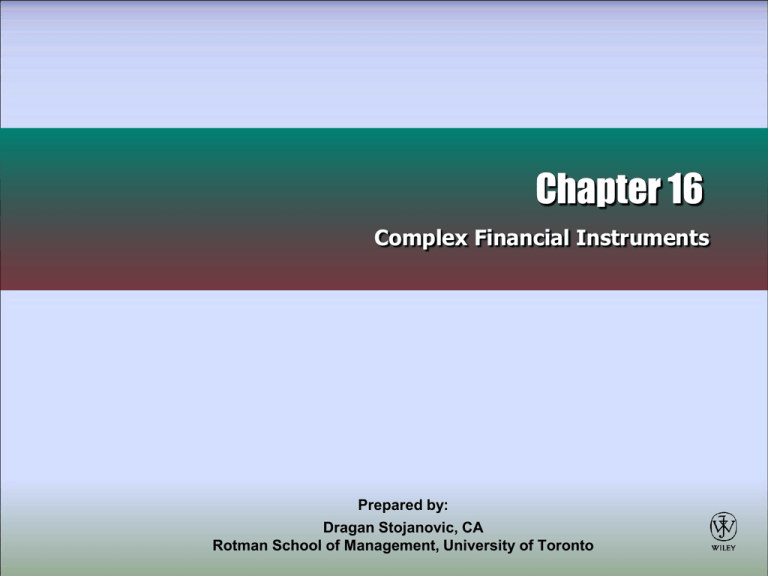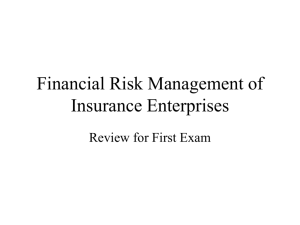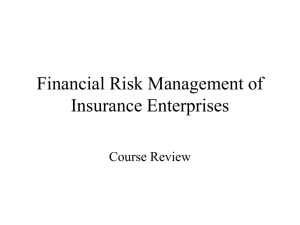
Chapter 16
Complex Financial Instruments
Prepared by:
Dragan Stojanovic, CA
Rotman School of Management, University of Toronto
Complex Financial Instruments
Derivatives
•Understanding
derivatives:
managing risk
•Recognition and
measurement
•Derivatives involving
the entity’s own
shares
Debt versus
Equity – Issuer
Perspective
Share-Based
Compensation
•Understanding the
economics of complex
financial instruments
•Special issues
•Presentation
•Types of plans
•Disclosure of
compensation plans
IFRS and Private
Enterprise GAAP
Comparison
•Comparison of IFRS
and private enterprise
GAAP
•Looking ahead
•Measurement
•Interest, dividends,
gains, and losses
2
Complex Financial Instruments
Derivatives
•Understanding
derivatives:
managing risk
•Recognition and
measurement
•Derivatives involving
the entity’s own
shares
Debt versus
Equity – Issuer
Perspective
Share-Based
Compensation
•Understanding the
economics of complex
financial instruments
•Special issues
•Presentation
•Types of plans
•Disclosure of
compensation plans
IFRS and Private
Enterprise GAAP
Comparison
•Comparison of IFRS
and private enterprise
GAAP
•Looking ahead
•Measurement
•Interest, dividends,
gains, and losses
3
Financial Instruments
• Financial instruments: contracts that create
both a financial asset for one party and a
financial liability or equity instrument for the
other party
• Financial instruments can be primary or
derivative
• Primary financial instruments: include most
basic financial assets and financial liabilities,
such as receivables and payables, and
equity instruments, such as shares
4
Derivative Instruments
•
Derivatives are financial instruments that
create rights and obligations, that transfer
financial risk from one party to the another
party
• Derivatives have the following characteristics:
1. Their value changes in response to the
underlying instrument (the “underlying”)
2. They require little or no initial investment
3. They are settled at a future date
5
Derivatives
•
Derivative instruments include:
1. Forwards
2. Futures
3. Options
•
Example: Stock Options
– The stock is the “underlying”
– If the share price goes up, the option is
worth more;
– If the share price goes down, the option
may become worthless
6
Financial Risks Defined
•
Derivatives are used to manage financial risks:
1. Credit Risk
– Risk to one party that the other party will fail to
meet an obligation
2. Liquidity Risk
– Risk of not being able to meet own financial
obligation
3. Market Risk
– Risk that fair value or future cash flows of a
financial instrument will fluctuate due to changes
in market price (includes currency risk, interest
rate risk, and other price risk)
7
Derivatives
•
Used by
1. Producers and Consumers
• Lock in future revenues or costs
2. Speculators and Arbitrageurs
• Generate cash profit from trading
• Maintain market liquidity
• Additional motivations to use derivatives
– Manage interest rate volatility
– Manage foreign exchange rate volatility
8
Recognition and Measurement of
Derivatives
•
Basic principles of accounting for derivatives:
1. Financial instruments (including financial derivatives)
and certain non-financial derivatives that meet
definitions of assets or liabilities should be reported in
financial statements when entity becomes party to the
contract
2. Derivatives should be reported at fair value (most
relevant)
3. Gains and losses should be recorded through net
income
•
Special accounting is used for items that have been
designated as being part of a hedging relationship
9
Non-financial Derivatives
•
•
Example of non-financial derivatives: contract to
buy steel at a specified date for a specified price
Are purchase commitments “derivatives”?
–
–
–
Value changes with value of the underlying
No investment up front
Settled in future
10
Accounting for purchase
commitments
•
Under ASPE / PE GAAP:
–
Not accounted for as derivatives because difficult
to measure
Recognized when goods received
–
•
Under IFRS
–
Not accounted for as derivatives, and recognized
when goods received if:
•
•
There are no net settlement features (can settle for
cash or other assets instead of taking delivery)
There are net settlement features, but company
intends to take delivery and therefore designates
contracts “expected use”
11
Derivative Instruments
•
Options
1. Call Option
•
Holder has the right, but not the
obligation, to purchase the “underlying” at
a preset (strike or exercise) price
2. Put Option
•
Holder has the right, but not the
obligation, to sell the “underlying” at a
preset price
12
A Framework for Options
Written
Call – right to buy
Put – right to sell
Sell option for $:
Sell option for $:
Transfer rights to buy
shares/underlying
Transfer right to sell
shares/underlying
Purchased Pay $ for option:
Obtain right to buy
shares/underlying
Pay $ for option:
Obtain right to sell
shares/underlying
13
Derivative Accounting - Example
Given:
• Call option entered into January 2, 2011
• Option expires April 30, 2011
• Option to purchase 1,000 shares at $100 per
share
• Share market price on January 2, 2011 is $100
per share
• Option is purchased for $400 (Option Premium)
• Share price on March 31st is $120 per share
• Option settled in cash on April 1, 2011
14
Accounting for Derivatives
Option Price Formula
Option
Intrinsic
=
Premium
Value
Market Price less
Strike (Exercise)
Price
Option
Premium
+
Time
Value
Option Value
Less
Intrinsic Value
= ($100 - $100) + ($400 - $0)
Journal Entries
15
Accounting for Derivatives
January 2 (acquisition date)
Derivatives – Financial Assets
Cash
400
400
March 31 (to record change in value of option)
Derivatives – Financial Assets
19,700*
Gain
19,700
Assume options are trading at $20,100
*(20,100 – 400)
April 1 (cash settlement of option)
Cash
20,000
Loss
100
Derivatives - Trading
20,100
Time Value lost through cash settlement before expiry
16
= $20,100 less intrinsic value of $20,000
Forwards
• Under a forward contract, parties each commit
upfront to do something in the future (obligation)
• Example: Assume on January 2, 2011, Abalone
Inc. agrees to buy $1,000 in U.S. currency for
$1,150 in Canadian currency in 30 days from
Bond Bank
• Abalone has the right to any increases in value
of the underlying (U.S. dollars), and an
obligation exists to pay a fixed amount of
$1,150 by a specified date
• This forward contract transfers the currency risk
inherent in the Canada-U.S. exchange rate
17
Forwards
• The value of the forward contract will vary
depending on interest rates as well as on the spot
prices (the current value) and forward prices
(future value) for the U.S. dollar
• If the U.S. dollar appreciates in value, in general,
this particular contract will have value to Abalone
• The forward is remeasured at fair value
• For example, if the fair value of the contract is
$50, on January 5, 2011, the journal entry is:
Derivatives – Financial Assets/Liabilities 50
Gain
50
18
Complex Financial Instruments
Derivatives
•Understanding
derivatives:
managing risk
•Recognition and
measurement
•Derivatives involving
the entity’s own
shares
Debt versus
Equity – Issuer
Perspective
Share-Based
Compensation
•Understanding the
economics of complex
financial instruments
•Special issues
•Presentation
•Types of plans
•Disclosure of
compensation plans
IFRS and Private
Enterprise GAAP
Comparison
•Comparison of IFRS
and private enterprise
GAAP
•Looking ahead
•Measurement
•Interest, dividends,
gains, and losses
19
Debt, Equity or Both?
Hybrid/combined instruments:
• Have characteristics of both debt and equity
(e.g. convertible debt)
• Are they debt, equity, or a bit of both?
• To determine appropriate presentation, must
consider:
– Contractual terms
– Economic substance
– Definitions of financial statement elements
20
Definitions Revisited
• Financial liability is any liability that is a
contractual obligation to do either of the
following:
1. Deliver cash or another financial asset to
another party, or
2. Exchange financial instruments with
another party under conditions that are
potentially unfavourable
• IFRS explicitly includes instruments settled
using variable number of shares as financial
liabilities
21
Definitions Revisited
• An equity instrument is any contract that
evidences a residual interest in the assets of
an entity after deducting all of its liabilities
• IFRS provides additional guidance when
instruments are settled through own shares
– Treated as equity only if settled by
exchanging fixed number of own equity
instrument for fixed amount of cash or other
assets
22
Measurement Issues
•
Hybrid/Combined instruments:
– Economic value stems from both the debt
component and the equity component
– Two measurement tools:
1. Residual value method (or incremental method)
2. Relative fair value method (or proportional method)
–
–
IFRS requires the use of residual method (with
debt valued first)
PE GAAP allows
1. equity component to be valued at zero, or
2. the use of residual method (with component that is
easier to measure being valued first)
23
Convertible Debt
• Bonds that are convertible to other forms of
securities (e.g. common shares) during a
specified period of time
• Combines the benefits of a bond (interest
payments, principal repayment) with the
privilege of exchanging the bond for shares at
the bondholder’s option
• Once the bond is converted, all interest and
principal no longer payable
24
Convertible Debt
Issued for two main reasons
1. Corporation can raise equity capital without
giving up unnecessary ownership control
2. It can also achieve equity financing at a lower
cost
• Conversion feature allows the corporation to
offer the bond issue at a lower coupon
• Conversion feature provides investor with an
opportunity to own equity - generally results
in the investor accepting a lower coupon rate
than with non-convertible debt
25
Convertible Debt – Accounting
Issues
•
The reporting of convertible debt and the
conversion feature result in three issues:
1. Reporting at the time of issuance
2. Reporting at the time of conversion
3. Reporting at the time of retirement
26
Convertible Debt — Example
Given:
• 3 year, $1,000,000 par value, 6% convertible
bonds
• Similar bonds (without conversion feature) have
a 9% interest rate
• Each $1,000 bond convertible to 250 common
shares (current market price of $3)
What portion of the proceeds are allocated to Bond
Liability, and what portion to equity?
27
Convertible Debt — Example
Total proceeds at par
=
$ 1,000,000
Fair value of the liability without the
conversion option (PV at 9%) =
$
924,061
Incremental value of option
$
75,939
Journal entry at issuance:
Cash
1,000,000
Bonds Payable
924,061
Contributed Surplus –
Conversion Rights
75,939
28
Convertible Debt — Example
• Conversion before maturity - assume that the
unamortized portion is $14,058
– therefore, book value of Bonds Payable is
1,000,000 – 14,058 = 985,942
• The entry to record the conversion would be
as follows:
Bonds Payable
985,942
Contributed Surplus - Conversion Rights 75,939
Common Shares
1,061,881
29
Induced Conversion
• When the corporation wants to entice or
induce the bondholders to convert their bonds
into shares
• Additional consideration – the “sweetener” –
offered to the bondholders to convert (cash,
common shares, etc.)
• The inducement is allocated between the
debt and equity components using a method
consistent with how instrument was first
recorded (e.g. incremental method)
30
Convertible Debt — Example
• Assume Bond Corp. offers an additional cash
premium of $15,000, when carrying amount of the
debt is $972,476 and bond’s fair value at date of
conversion is $981,462
• $981,462 - $972,476 = $8,986 (debt retirement cost)
Bonds Payable
972,476
Expense – Debt Retirement
8,986
Contributed Surplus – Conversion Rights 75,939*
Retained Earnings (15,000 – 8,986)
6,014
Common Shares
1,048,415
Cash
15,000
* Calculated previously using Incremental Method
31
Reporting at the
Time of Retirement
• Treated the same as debt retirement from
Chapter 14 for non-convertible bonds
– Clear any outstanding premiums,
discounts, bond issue costs, interest
accrued to bondholders
– The conversion rights account must be
reallocated
– Equity components remains in Contributed
Surplus
32
Convertible Debt — Example
• Assume that Bond Corp. decides to retire the
convertible debt early and offers the
bondholders $1,070,000 cash
Bonds Payable
972,476
Expense – Debt Retirement
8,986
Contributed Surplus – Conversion Rights 75,939
Retained Earnings
12,599
Cash
1,070,000
33
Interest, Dividends, Gains/Losses
• The related interest, dividends, gains, and
losses must be consistently treated as the
financial instrument they relate to
• Example: term preferred share
– presented as a liability
– related dividends would be recorded as interest
expense (or dividend expense) and charged to
the income statement (instead of Retained
Earnings)
34
Complex Financial Instruments
Derivatives
•Understanding
derivatives:
managing risk
•Recognition and
measurement
•Derivatives involving
the entity’s own
shares
Debt versus
Equity – Issuer
Perspective
Share-Based
Compensation
•Understanding the
economics of complex
financial instruments
•Special issues
•Presentation
•Types of plans
•Disclosure of
compensation plans
IFRS and Private
Enterprise GAAP
Comparison
•Comparison of IFRS
and private enterprise
GAAP
•Looking ahead
•Measurement
•Interest, dividends,
gains, and losses
35
Types of Compensation Plans
1.
2.
3.
4.
Compensatory stock option plans (CSOP)
Direct awards of stock
Stock appreciation rights plans (SAR)
Performance-type plans
36
Stock Compensation Plans
•
•
•
A form of stock warrant — a stock option
Provides the employee with an opportunity to
purchase shares at a given price, within a
specified period of time
Two accounting issues associated with stock
compensation plans
1. Determination of compensation expense
2. Periods of allocation for compensation expense
amounts
37
Uses of Stock Options
Stock Options
Issued by other e.g.
Financial institutions
Issued by the company
CSOP ESOP
Not traded on
Exchange since must
Be employee to hold
Other
Options/
Warrants
Not traded on
Exchange since
Rights usually not
transferable
Often exchange
traded
38
Compensatory vs. NonCompensatory Plans
Stock Options
Compensatory
CSOP
Operating transactions
Income
Statement
Non-compensatory
ESOP
Capital transactions
Shareholders’
Equity
39
Compensatory vs. NonCompensatory Plans
Factors to determine if a plan is compensatory
1. Option terms
• Non-standard terms implies compensatory
2. Discount from market price
• Implies compensatory
3. Eligibility
• If available to only a certain group of
employees (i.e. management)
40
Non-Compensatory - Example
• Fanco Limited set up an ESOP that gives
employees the option to purchase shares for $10
per share
• On January 1, 2011, employees purchase 6,000
options for $6,000:
Cash
6,000
Contributed Surplus-Options
6,000
• If employees exercise all 6,000 options:
Cash (6,000 x $10)
60,000
Contributed Surplus-Options
6,000
Common Shares
66,000
41
Stock Options - Important
Dates
Work
start date
Grant
date
Vesting
date
Exercise
date
Expiration
date
Options
are
granted to
employee
Date that
employee
can first
exercise
options
Employee
exercises
options
Unexercised
options
expire
42
Options: Allocating Compensation
Expense
is determined as of the
measurement date
Compensation Expense
and is allocated over
the service period
• The service period is the period benefited by
employee’s service
• It is usually the period between the grant date
and the vesting date
43
Compensation Expense - Example
• On January 1, 2012, Chen Corp grants five
executives the options to purchase 2,000 shares
each
• The option price per share is $60, and the market
price is $70 per share when options are granted
• The fair value, determined by an option pricing model,
results in compensation expense of $220,000
• Assuming expected period of service is two years,
journal entries at year end for 2012 and 2013:
Compensation Expense
110,000
Contributed Surplus – Stock Options 110,000
($220,000 / 2)
44
Compensation Expense - Example
• If 20% or 2,000 of the 10,000 options were exercised
on June 1, 2015, journal entry is:
Cash (2,000 x $60)
120,000
Contributed Surplus–Stock Options
(20% x $220,000)
44,000
Common Shares
164,000
• If the remaining stock options are not exercised before
their expiration date, journal entry is:
Contributed Surplus–Stock Options 176,000
Contributed Surplus-Expired Options 176,000
(80% x $220,000)
45
Direct Stock Awards
• Non-monetary reciprocal transaction
– Little or no cash involved
– Two-way transaction
• the company gives something up (shares) and
gets the employee’s services in return
• Recorded at fair value of the shares
46
Compensation Plan Disclosure
• Following is fully disclosed
– Accounting policy used
– Description of the plans and modifications
– Details of number and values of options
issued, exercised, forfeited, and expired
– Description of assumptions and methods used
to determine fair values
– Total compensation cost included in net
income/contributed surplus, and
– Other
47
Complex Financial Instruments
Derivatives
•Understanding
derivatives:
managing risk
•Recognition and
measurement
•Derivatives involving
the entity’s own
shares
Debt versus
Equity – Issuer
Perspective
Share-Based
Compensation
•Understanding the
economics of complex
financial instruments
•Special issues
•Presentation
•Types of plans
•Disclosure of
compensation plans
IFRS and Private
Enterprise GAAP
Comparison
•Comparison of IFRS
and private enterprise
GAAP
•Looking ahead
•Measurement
•Interest, dividends,
gains, and losses
48
Looking Ahead
• There are a number of IASB projects that are
expected to simplify and promote consistent
application of accounting standards for
financial instruments
49
COPYRIGHT
Copyright © 2010 John Wiley & Sons Canada, Ltd.
All rights reserved. Reproduction or translation of
this work beyond that permitted by Access Copyright
(The Canadian Copyright Licensing Agency) is
unlawful. Requests for further information should be
addressed to the Permissions Department, John
Wiley & Sons Canada, Ltd. The purchaser may make
back-up copies for his or her own use only and not
for distribution or resale. The author and the
publisher assume no responsibility for errors,
omissions, or damages caused by the use of these
programs or from the use of the information
contained herein.
50








